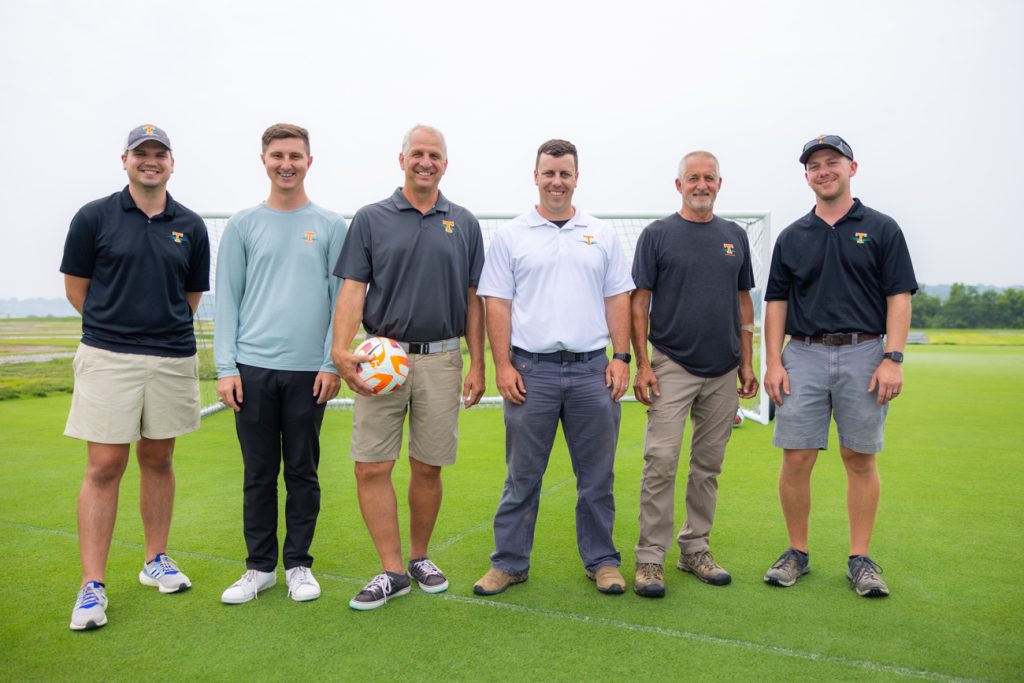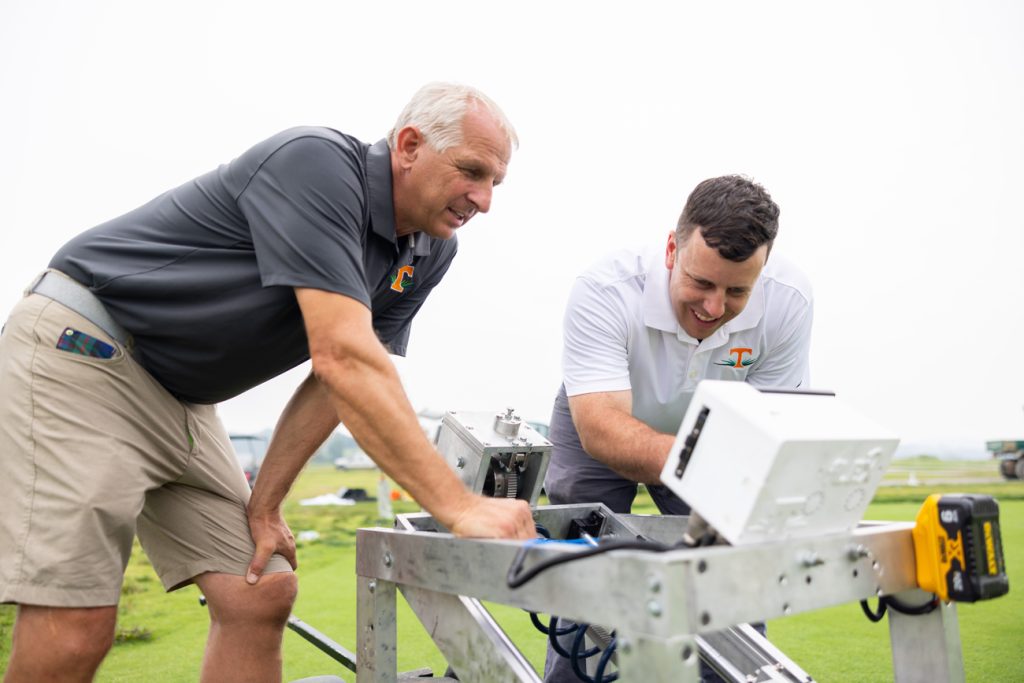UT Professor John Sorochan leads the effort to develop turfgrasses for 16 World Cup venues across North America
So the first question is, how did it happen? Why did FIFA—soccer’s international governing body based in Zurich, Switzerland—put John Sorochan, a distinguished professor of turfgrass science and management at the University of Tennessee, in charge of developing and installing the different turfgrasses for the 16 stadiums, 84 training sites, and 178 practice fields across North America for the 2026 World Cup?
“It’s all about relationships,” he explains. Sorochan (pronounced SOR-ah-kin), a Calgary, Alberta, native, has a western-Canadian affability and lack of pretense that help him connect with turf experts all over the world and share insights about soil, lighting, drainage, varieties of grass—and their impact on playability of soccer pitches, golf courses, and other sports venues. Chatting with him in the bustling Capybara Coffee Shop in University Commons feels like meeting up with an old friend. He and his wife, Lisa, are coffee aficionados who get special bags of Brazilian coffee from Cabybara’s owner. (Don’t tell!) They met one evening in the late 90s at half-off-bottle-of-wine night at Beggar’s Banquet in East Lansing, Michigan, over a Columbia Crest Shiraz. She was finishing her English degree but his excitement about his field led her to go on for a master’s in crop and soil science. When Sorochan talks about turf, people, including other experts, get excited about it.
The FIFA connection? It was Alan Ferguson, a Scotsman who has managed the turf at storied St. Andrews, the Football Association St. George’s Park National Football Centre, and Wembley Stadium, to name just three venues. Around 2005 Sorochan met Ferguson at an international turf conference, and they became friends. In July 2016 they met again on Sorochan’s London visit to Tottenham All-England FC while he was in England for Wimbledon. In September, Sorochan crossed the pond again as the NFL Players Association field inspector for an NFL game at Wembley. “I had tea with Alan and his wife, Carol,” he says.

In 2017 FIFA hired Ferguson. “It was the first time they hired a groundsman,” says Sorochan. “He totally elevated the quality of everything they do.” In 2019, over fall break, Sorochan went over to England for the week. “Alan, then leading the effort in Qatar, talked about the research that was going to be needed for 2026,” remembers Sorochan. “He’s the one that pushed for me.”
The World Cup, which will include 48 teams instead of the usual 32, will kick off on June 11, 2026, in Mexico City. The final will be at MetLife Stadium in New Jersey on July 19, 2026. In between games will be played in Guadalajara and Monterrey, Mexico; Atlanta, Boston, Dallas, Houston, Kansas City, Los Angeles, Miami, Philadelphia, San Francisco, Seattle, Toronto, and Vancouver.
“It’s important that we get these pitches playing and looking as identical as we can,” said Sorochan in a FIFA release. “Whether it’s a stadium in Canada, in the Midwest US, or down in the mountains of Mexico, we want there to be consistency with what a player feels under his foot. For us, it’s all about the consistency of the playability for the player.” Or, put another way in Capybara’s, “At every pitch and practice field, the ball should bounce the same.” In this mammoth research effort, Sorochan is working in collaboration with old friends and mentors from his alma mater, Michigan State.
“One of the easiest decisions I have made around this tournament so far was the partnering of Tennessee and Michigan State universities,” said Ferguson in a FIFA release. “Both already had world-leading reputations. Both were already led by world-leading professors. I didn’t want to reinvent the wheel. It was already here.”
The Worst Poker Face to Be a Lawyer
Sorochan grew up playing soccer in Calgary, a town known for its cowboys and oilmen. His neighbor’s dad was a golf course superintendent, and his neighbor went to Michigan State to study turfgrass, then moved to Spain to build golf courses in Europe and Morocco. In Sorochan’s senior year of high school he tore his ACL in football, ending his soccer dreams but giving him a sensitivity to turf and injuries. “In our focus on consistency and uniformity,” he says, “there are always three factors: the surface, the shoe, the athlete.”

Sorochan started at the University of Calgary majoring in political science and geology, thinking he would be a lawyer. He soon realized, “I have the worst poker face to be a good lawyer.” One summer he worked at Calgary’s Earl Gray Golf Club. “I fell in love with the job,” he says. He transferred to MSU’s turfgrass management program, thinking he’d get into golf course design and management, like his neighbor friend. But in 1994 he worked under his mentors Trey Rogers and research technician John Stier on the challenge posed by the 1994 World Cup of putting natural grass inside the Pontiac Silverdome. They developed a method of using hexagon-shaped modules of sod grown on plastic and keeping them alive with grow lights. At a certain point Stier took Sorochan aside and told him he should go to graduate school, and so began Sorochan’s master’s and then his PhD in crop and soil science.
By chance Lisa’s parents had retired to Tellico Village in 1999, so John and Lisa had gotten to know the area. In 2001, when they were visiting for Thanksgiving, John interviewed at UT. He started at UT in May 2002, just after he finished his PhD. Lisa, while remaining a turf expert, got her BS in nursing at UT in 2009. She now works as an investment associate with Axiom Wealth Management-Northwestern Mutual. Their son Ian is entering his sophomore year in food science in UT’s Herbert College of Agriculture. Charlie, a rising junior at Farragut High, plays for a One Knox club team. It is a hectic life being a parent and an international turfgrass authority. “I couldn’t do what I do without her,” says John.
“Easily my favorite part of my job is all the people I get to work with and meet,” said Sorochan in a UTIA post in 2023. “I love mentoring and educating undergraduates and watching them go on to have successful careers in the turfgrass industry. Staying in touch with past students and helping them with their next job or career choice, sometimes even 10 years after they graduate, is very rewarding.” His students have interned at Wimbledon, the top golf courses, and NFL stadiums.
When FIFA Visits Knoxville
As part of its commitment to UT, FIFA donated the funds for a 5,000-square-foot controlled environment on Alcoa Highway. The FIFA Indoor Research Building was completed in December 2023. “It’s like an airport hangar with grow lights nurturing dozens of different varieties of grass,” says Sorochan. In April a FIFA delegation visited UT and the research facility as part of “FIFA Pitch Research Field Day.”
Instead of the hexagonal-shaped pods of 1994, sod is now grown in strips 50 feet long and three feet wide on a hybrid natural grass and synthetic turf-like system that can be rolled up and moved to fields. Of the 16 venues, five have retractable roofs and half have artificial turf that has be replaced for the World Cup. In NFL stadia, the fields have to be widened and seats removed to accommodate the larger soccer pitches.
“It’s overwhelming thinking about it, being a part of the world’s largest athletic event by far,” Sorochan says. “I have been fortunate to meet and share experiences with students, teachers, and researchers from all corners of the globe. The opportunities in turfgrass science, for myself and our students, are endless. I have the best job in the world.”

Comments are closed.